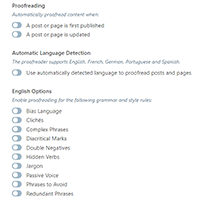I get a website audit sent to me every month by the search engine marketing solution SEMrush (be sure to read the full review of SEMrush by Joe Fylan).
The audit is free as it only scans a certain portion of your website. They do more comprehensive reports if you upgrade to one of their monthly premium plans.
If I’m honest with you all, I have never spent too much time optimising my websites for search engines. I use SEO friendly WordPress designs and SEO WordPress plugins and I always add a meta description and optimised page title to my posts and pages. However, I don’t spend days tweaking and optimising my pages as I would rather focus my time on producing more content.
Despite my focus being more on content, as a website owner I simply cannot ignore glaring website issues that need addressed, therefore I have decided to address the issues being raised by SEMrush and improve my SEO score.
Last month my SEMrush website rating was 77%. This month it dropped to 65%. This was not due to any major change on my website, but just a lot of little things that happen when running a website. For example, for some reason one image was displaying an error because of Cloudflare and this generated 10 errors instead of one.
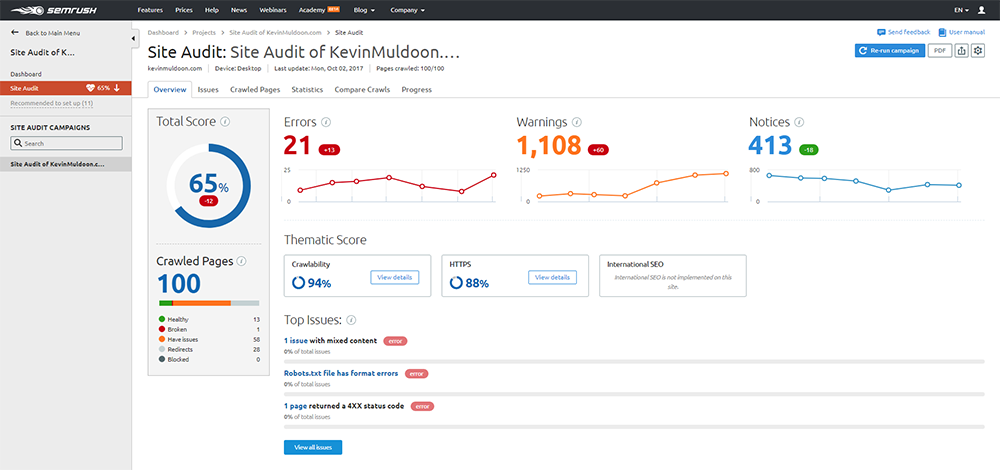
In this article I would like to talk about how I am going to fix my SEO problems and improve my score by addressing the errors, warnings, and notices that SEMrush shows.
A Quick Note About the SEMrush Website Audit
The free website audit that SEMrush provides is just a simple snapshot of 100 pages on my website as I have not opted for a premium plan.
I have around 1,400 published blog posts and pages and many more archive pages. This means that the true number of errors, warnings, and notices, for my website, is much higher. However, when I resolve an issue with a template change or setting change, it should resolve the issue on all pages on my website and not just the 100 sampled pages.
SEO Errors
SEMrush states that I currently have 21 errors.
They note that errors are the issues on my website with the highest severity.
The number of issues of the highest severity detected on your website during the last audit. You can also see the difference in the number of errors found during your previous and last audits.
The trend graph below shows how your website’s health has improved over the last seven audits.
Since errors have the highest severity, I have to place more focus on resolving these. SEMrush makes the process of resolving problems simple as next to each problem is a “Why and how to fix it” box that explains the problem and…well, how to fix it.
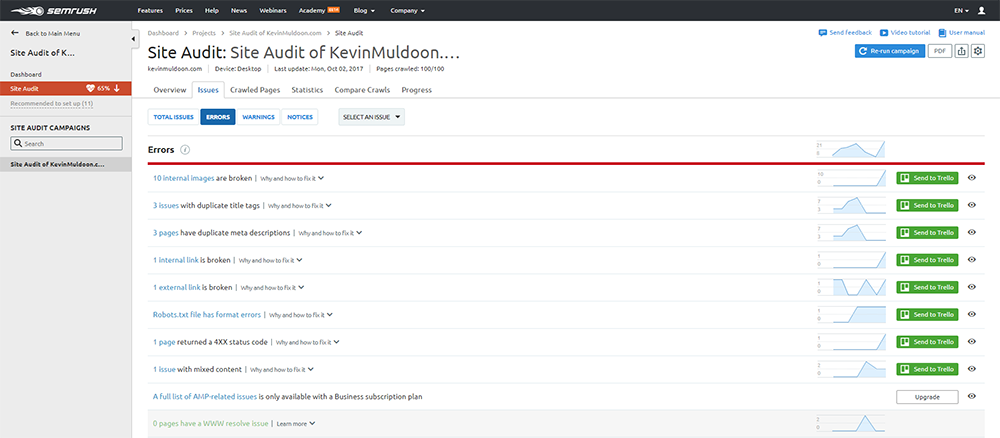
The top error for me stated that 10 internal images were broken. All of these errors were related to one thumbnail image.
When I clicked on the image I was shown a Error 1011 message by my content delivery network Cloudflare.
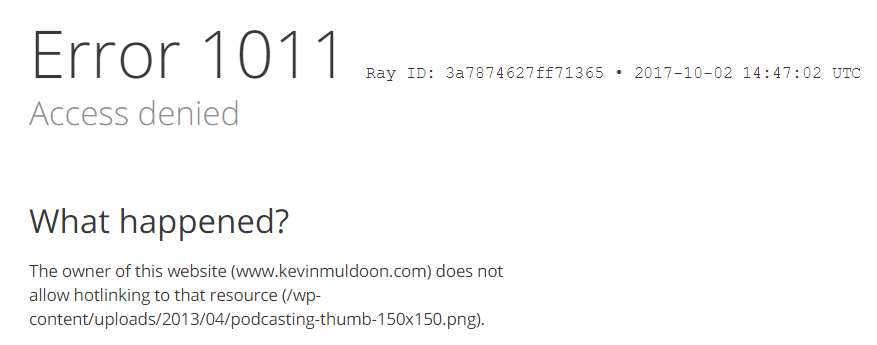
The error message notes that the owner of the website does not allow hotlinking. This looks to have been caused by me switching from HTTP to HTTPS; although I am puzzled as to one random post thumbnail is causing this and not the thousands of other images on my website.
Disabling the ScrapeShield hotlinking feature on Cloudfare appears to have fixed these errors, but that is a short-term solution. I will need to look into how to stop this from occurring again.
The next error I had to resolve was three pages which have duplicate title tags. The pages in question were archive index pages e.g. https://www.kevinmuldoon.com/page/2/, https://www.kevinmuldoon.com/page/3/ etc. All of these pages had the same title as my home page, which makes it difficult for search engines to distinguish one page from the next.
I followed the advice of Tom Dupuis in his excellent guide of Yoast’s WordPress SEO and noindex’d the sub-pages of archives.
The internal link error was an easy fix. An author who wrote a review for me a few years ago had not added http:// to the link. Adding it to the link resolved the issue and also fixed the error that stated “1 page returned a 4XX status code”.
The external link error was related to a website I linked to that was offline. When the website came back online, the error was no longer an issue.
Another error that was noted stated that my Robots.txt file had format errors. All that referred to was the fact my sitemaps were being linked to HTTP and not HTTPS.
The one error I am not sure how to resolve is “1 issue with mixed content”. It’s stating that my contact page a logo symbol from Rise Forums. There is nothing like that on the page so I am unsure as to how or why this error is there. Bizarre.
SEO Warnings
SEMrush reported a huge 1,108 warnings for my website. These are described as medium severity.
The number of issues of medium severity detected on your website during the last audit. You can also see the difference in the number of warnings found during your previous and last audits.
The trend graph below shows how your website’s health has improved over the last seven audits.
1,108 warnings sounds like a lot, however 939 warnings were regarding links on HTTPS pages linking to HTTP pages. This refers to the many internal links that are linking to my website pages using HTTP. This is something I should have addressed after changing from switching from HTTP to HTTPS.
To address this problem, I used the WordPress plugin Better Search Replace to replace all instances of https://www.kevinmuldoon.com on my blog to https://www.kevinmuldoon.com.
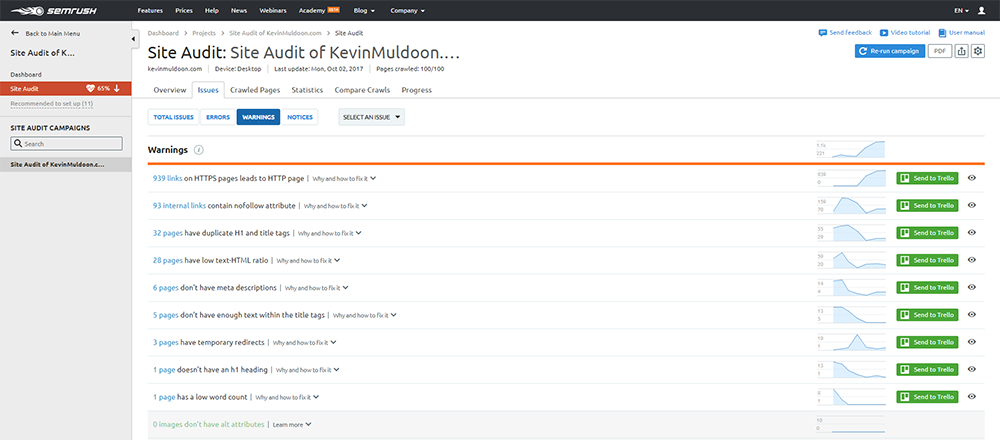
93 errors referred to internal links that contained the nofollow attribute. The interesting thing is that all of these errors were referring to two links on my sidebar: My RSS feed and my link to bluehost. Changing the links to HTTPS fixed the errors.
Some warnings are not a major concern.
For example, they warned me that my YouTube page has a low word count. I could add more text to that page, but the whole focus of that page is to highlight videos from my YouTube channels. It is not an article and simply a way to showcase my latest video content.
Likewise, the three pages they noted that had temporary redirects referred to affiliate links that had been masked; therefore it is not something I’m overly concerned about.
Another warning I’m not concerned too much about is the low text-HTML ratio warning. I generated 28 warnings for low text-HTML ratio, though most of these pages refer to archive pages, such as my home page, author archives, blog post categories, etc. A couple of list style articles were referenced here too, which is understandable since these resources mainly link to useful products and services.
Other warnings I addressed:
- 6 pages don’t have meta descriptions – I used “Author profile of %%name%% at %%sitename%%” in WordPress SEO for the many author pages that did not have descriptions and updated the meta description of my guides page
- 5 pages don’t have enough text within the title tags – I had to change the page title of pages that had titles with less than 10 characters
- 1 page doesn’t have an h1 heading – This relates to the Genesis framework not displaying a H1 header tag in category archives – I resolved this by following this tutorial by App Shah
The last warning I had to address was that 32 pages have duplicate H1 and title tags.
This issue was resolved by following Tom Dupuis’s Yoast WordPress SEO guide and changing the post and page titles from %%title%% to %%title%% %%sep%% %%sitename%%.
What this did was append a seperator and my website name (Kevin Muldoon) to each post and page on my website. This ensured my page titles in the browser tab and in the content area are different.
SEO Notices
SEMrush advised that I had 413 notices. Notices are not considered serious issues, but they still recommend addressing them.
The number of notices detected on your website during the last audit. You can also see the difference in the number of notices found during your previous and last audits. Although notices are not considered issues, we recommend that you fix them.The trend graph below shows how your website’s health has improved over the last seven audits.
The notices referred to two separate issues.
The first issue is that 411 external links contain nofollow attributes and the second issue is that 2 subdomains don’t support HSTS.

SEMrush notes that:
A nofollow attribute is an element in an anchor tag that tells crawlers not to follow the link. “Nofollow” links don’t pass any link juice or anchor texts to referred webpages. The unintentional use of nofollow attributes may have a negative impact on the crawling process and your rankings.
All of the 411 external links refer to the social media sharing links that are displayed in my posts and pages. I believe it is better to keep these links as nofollow.
The last issue states that my subdomains kevinmuldoon.com and www.kevinmuldoon.com are not using HTTP Strict Transport Security. This is someting I can going to look into more and possibly implement in the future.
Final Thoughts
Improving my SEMrush score is no guarantee my website is perfectly optimised for search engines and it does not mean that I will get an avalanche of traffic. Though, it is well documented that when a website addresses website errors and makes it easier for search engines to crawl its data, it normally results in a better search engine ranking. This in turn leads to more traffic from search engines.
When my website audit is performed next month I should see an improved score. Whilst this is desirable, the goal is to make my website easier to crawl for search engines.
Time will tell whether these changes will result in better search engine rankings and and increase is search engine traffic.
Thanks for reading.
Kevin

